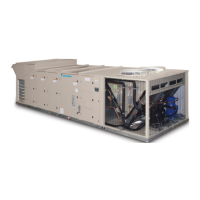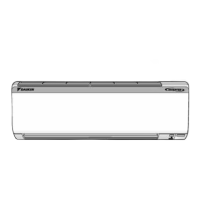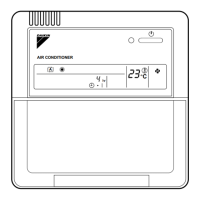Do you have a question about the Daikin MPS035 F and is the answer not in the manual?
Details danger, warning, and caution statements for hazardous situations and potential injuries.
Outlines the installer's duties regarding regulations, codes, and safe practices for installation.
Provides critical safety warnings and instructions for lifting and handling the unit using appropriate equipment and techniques.
Details the field installation and connection of static pressure taps for VAV units, emphasizing proper location and tubing.
Explains how to field install static pressure taps for building pressurization control, covering both building envelope and lab applications.
Covers compliance with codes, warranty voiding for incorrect wiring, and details on power connection points and wire sizing.
Details the specifications, safety warnings, and clearances for the tubular heater series package heater module.
Provides instructions for installing the flue box and outdoor air hood, which ship separately to maintain unit width.
Specifies the acceptable gas pressure range for the main gas valve and requirements for high-pressure regulators.
Covers gas piping sizing, installation in accordance with codes, support, and leak testing procedures.
Details the specific pressure adjustments for natural gas fuel for both two-stage and modulating furnaces.
Provides pressure adjustment procedures for propane gas fuel, covering two-stage and modulating furnace configurations.
Details the step-by-step sequence for the low heat option, including unit and furnace control calls and safety checks.
Details the step-by-step sequence for the low heat option, including unit and furnace control calls and safety checks.
Explains the sequence of operation for the high heat option, involving multiple stages and furnace modules.
Describes the operation sequence for the low heat option with modulation, focusing on burner control and discharge air temperature.
Describes the operation sequence for the low heat option with modulation, focusing on burner control and discharge air temperature.
Details the sequence for the high heat option with modulation, including dual burners and staging for temperature control.
Details the essential checks and tests required before starting the unit to ensure proper operation and warranty coverage.
Defines the responsibilities of the start-up organization for ensuring the furnace operates within specified limits.
Covers initial checks before starting the furnace, including fan wheel, power, gas lines, and leak checks.
Provides the step-by-step procedure for starting the unit, including setting the thermostat, controlling gas, and checking for operation.
Recommends checking and replacing air filters monthly.
Explains the role of the electronic controller in managing modulating furnaces, including safety inputs and outputs.
Provides a troubleshooting guide for modulating gas furnaces using LED indicators on the ignition control module.
Explains the design of the electric heat rooftop unit, including heating coils, staging control, and safety switches.
Describes the hot gas reheat coil option for dehumidification, involving over-cooling and reheating with hot gas.
Explains the hot water coil option, including its configuration, piping vestibule, and available heat capacities.
Explains the principle of energy recovery using an enthalpy wheel and its control methods.
Explains Daikin's head pressure control using VFD fans for low ambient operation down to 0F.
Details VFD compressor operation, including control signals, speed ranges, and interaction with fixed speed compressors.
Explains how VFD compressor control is achieved using digital output and analog signals for modulation.
Outlines the start-up sequence for VFD compressors, including enabling output, initial ramp, and modulation for discharge setpoint.
Details various control functions that protect the VFD compressor from damage due to abnormal operating conditions.
Explains how high discharge pressure is managed by reducing compressor speed or locking out the compressor.
Describes how high discharge line temperatures trigger compressor speed reduction or shutdown to prevent damage.
Explains how the unit controller monitors discharge superheat to protect the VFD compressor from issues like flood back.
Details the emergency stop control function that activates when VFD run verification input is not received after a set period.
Discusses variable speed scroll compressors, their benefits, and how they are engineered for energy efficiency and comfort.
Details the VFD compressor drive, its programming, parameters, and basic operation modes like start, stop, and modulation.
Details the unit's heating mode control, influenced by control temperature and setpoint, including staging logic.
Explains cooling mode control for CAV units using space temperature, including setpoint and stage timing.
Details the essential checks and tests required before starting the unit to ensure proper operation and warranty coverage.
Guides on starting the supply fan, including removing shipping bolts, checking alignment, and verifying rotation.
Details how to start the economizer, checking outdoor air suitability and setting cooling setpoints for proper operation.
Outlines crucial steps for compressor start-up, including checking for leaks, refrigerant charge, and fan blade positioning.
Explains how to verify the correct rotational direction of scroll compressors and the consequences of reverse rotation.
Provides a procedure for checking compressor operation, including starting, running continuously, and troubleshooting low-pressure switch cycling.
Details the process for checking subcooling, involving measuring pressures and temperatures to assess refrigerant charge.
Explains how to adjust expansion valve superheat to prevent floodback and ensure optimal system capacity and compressor life.
Guides on setting heating, cooling, and other operational parameters for the MicroTech III controller.
Emphasizes that service must be performed by qualified personnel familiar with hazards and regulations.
Highlights the importance of preventive maintenance for avoiding expenses and inconvenience, listing routine inspection items.
Details recommended cleaning procedures for Option E Coated Coils to maintain warranty coverage and performance.
Lists approved cleaning agents for Option E Coated Coils to remove mold, mildew, dust, and greasy residue.
Explains the function of the Manual Motor Protector (MMP), including its protection features and adjustment procedures.
Details the thermal overload relay's function for current-dependent protection and its adjustment and reset procedures.
Explains circuit breakers installed upstream of VFDs for short circuit protection, including reset procedures and handle positions.
Explains the Phase Voltage Monitor's role in protecting three-phase loads from power line issues, including LED indicators.
Explains the procedure for lubricating motor bearings, emphasizing correct grease type and avoiding overlubrication.
Provides maintenance procedures for the energy recovery wheel, including cleaning and component checks.
Emphasizes disconnecting power before servicing control panel components and inspecting for multiple disconnects.
Explains the need for periodic cleaning of the energy recovery wheel due to operating schedules and contaminants.
Explains the need for periodic cleaning of the energy recovery wheel due to operating schedules and contaminants.
Provides instructions for installing and replacing wheel segments, including segment retainers and balancing steps.
Details the procedure for replacing the wheel drive motor and pulley, including belt removal and securing the set screw.
Gives step-by-step instructions for replacing the belt, including accessing bearings and reinstalling seals.
Provides a table for troubleshooting common symptoms and causes related to the energy recovery wheel.
States that the unit nameplate references proper refrigerant charge for each circuit.
Covers the servicing of refrigerant sensors and switches, including low and high pressure switches.
Explains how to obtain replacement parts, requiring model and serial numbers, and provides contact information.
Checklist for compressor start-up, verifying holding charges, rotation direction, and overall unit start-up sequence.
Section for recording performance data, including compressor voltage, amperage, pressures, and temperatures.
Checklist for verifying electrical heat service, physical condition of coils, terminal tightness, and voltage/amp draw.
Checklist for gas burner start-up, including furnace model, firing rate, altitude, gas pressure, and CO2 levels.
| Brand | Daikin |
|---|---|
| Model | MPS035 F |
| Category | Air Conditioner |
| Language | English |












